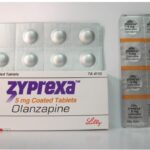What Happens if a Normal Person Takes Olanzapine pills?

What Is Olanzapine And What Does It Treat?
Olanzapine is a prescription antipsychotic medication that works in the brain to treat schizophrenia a chronic psychiatric disorder. People with this disorder experience distortion of reality, often experiencing delusions or hallucinations. Although exact estimates are difficult to obtain, it’s estimated to affect about 1 percent of the population.
Misconceptions about this disorder are common. For example, some people think it creates a “split personality.” In fact, schizophrenia and split personality — properly termed dissociative identity disorder — are two different disorders. Schizophrenia can occur in men and women of all ages. Men often develop symptoms in their late teens or early 20s. Women tend to show signs in their late 20s and early 30s. Here’s what you need to know.
Olanzapine a second-generation antipsychotic (SGA) or atypical antipsychotic rebalances dopamine and serotonin to improve thinking, mood, and behavior and help manage these symptoms. Olanzapine may help some or all of these symptoms.
Olanzapine is also FDA approved for the following indications:
• Acute treatment of manic or mixed episodes of bipolar disorder
• Maintenance (long-term) treatment of bipolar disorders
• Acute treatment of agitation in schizophrenia and bipolar disorder
Olanzapine may also be helpful when prescribed “off-label” for prevention of chemotherapy-associated acute and delayed nausea or vomiting, chemotherapy-associated breakthrough nausea or vomiting, delirium, delusional parasitosis, post-traumatic stress disorder, Tourette syndrome, and other mental health conditions. “Off-label” means that it has not been approved by the Food and Drug Administration for this condition. Your mental health provider should justify his or her thinking in recommending an “off-label” treatment. They should be clear about the limits of the research around that medication and if there are any other options.
How should Olanzapine be used?
Olanzapine comes as a tablet and an orally disintegrating tablet (tablet that dissolves quickly in the mouth) to take by mouth. It is usually taken once a day with or without food. Take olanzapine at around the same time every day. Follow the directions on your prescription label carefully, and ask your doctor or pharmacist to explain any part you do not understand. Take olanzapine exactly as directed. Do not take more or less of it or take it more often than prescribed by your doctor.
Do not try to push the orally disintegrating tablet through the foil. Instead, use dry hands to peel back the foil packaging. Immediately take out the tablet and place it in your mouth. The tablet will quickly dissolve and can be swallowed with or without liquid.
Your doctor may start you on a low dose of olanzapine and gradually increase your dose.
Olanzapine may help control your symptoms, but it will not cure your condition. It may take several weeks or longer before you feel the full benefit of olanzapine. Continue to take olanzapine even if you feel well. Do not stop taking olanzapine without talking to your doctor. Your doctor will probably want to decrease your dose gradually.
What happens if a normal person takes olanzapine?
As earlier stated, a lot of people who do not suffer from any mental health condition use Olanzapine “Off-label” for medical reasons. When normal people take olanzapine, it can cause constipation and weight gain sometimes by as much as 3 kgs in less than 2 months according to studies. Other side effects that can occur include:
• Dizziness/low blood pressure upon standing
• High levels of triglycerides in the blood
• High cholesterol
• Drowsiness
• Extrapyramidal symptoms (muscle spasms, jerky movements, slow movements)
• Dry mouth
• Weakness
• Dizziness
• Accidental injury
• Insomnia
• Elevated alanine aminotransferase (ALT) level
• Constipation
• Indigestion
• Elevated levels of prolactin in the blood
• High blood sugar
• Low blood pressure
• Tremor
• Weakness
• Restlessness
• Parkinsonism reactions
This document does not contain all possible side effects and others may occur. Check with your physician for additional information about side effects.





